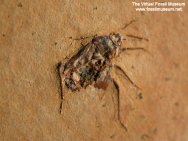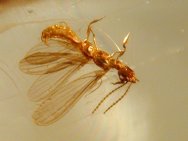 Unlike
the trilobite that has
left a prodigious fossil
record,
the preservation of insects in sedimentary matrix is relatively
rare, and essentially limited to the Lagerstätte sites.
The reason for the scarcity of insect fossil is the poor
preservation
potential of the insect's exoskeleton. Like other Arthropods,
insects have an external skeleton called an exoskeleton.
Unlike
the thick and calcified trilobite exoskeleton, the insect exoskeleton
is made of a thin, plastic-like material called chitin,
along
with a tough protein. This thin, waterproof covering simply
does not preserve well in most oxygenated environments,
making
insect fossils sparse despite the tremendous number that could
have been preserved. The exception is in fossil
resinite (amber, by street name), where it is possible
for even the minutest details to be preserved right
down to fragments
of DNA. Despite their huge strength to weight ratio, insects
were often too small to escape the sticky resin exuded
by trees,
and which later became a fossil itself, with physical properties
akin to modern polymerized plastics. Countering low
probability
of fossilization is the prodigious fecundity of insects. While
lifetime insect fecundity varies enormously across taxa,
from
less than ten to several millions of eggs, most insects lay
between a couple of hundred to a couple of thousand
eggs (Hinton
1981). Unlike
the trilobite that has
left a prodigious fossil
record,
the preservation of insects in sedimentary matrix is relatively
rare, and essentially limited to the Lagerstätte sites.
The reason for the scarcity of insect fossil is the poor
preservation
potential of the insect's exoskeleton. Like other Arthropods,
insects have an external skeleton called an exoskeleton.
Unlike
the thick and calcified trilobite exoskeleton, the insect exoskeleton
is made of a thin, plastic-like material called chitin,
along
with a tough protein. This thin, waterproof covering simply
does not preserve well in most oxygenated environments,
making
insect fossils sparse despite the tremendous number that could
have been preserved. The exception is in fossil
resinite (amber, by street name), where it is possible
for even the minutest details to be preserved right
down to fragments
of DNA. Despite their huge strength to weight ratio, insects
were often too small to escape the sticky resin exuded
by trees,
and which later became a fossil itself, with physical properties
akin to modern polymerized plastics. Countering low
probability
of fossilization is the prodigious fecundity of insects. While
lifetime insect fecundity varies enormously across taxa,
from
less than ten to several millions of eggs, most insects lay
between a couple of hundred to a couple of thousand
eggs (Hinton
1981).
Insect
evolution is a powerful illustration of decent with modification.
The earliest known insects are tiny wingless forms from the
early and middle Devonian.
Insect flight developed with suddenness resembling the Cambrian
explosion during the middle Carboniferous, apparently the result
of the significant survival advantage that was accrued. By the
end of the Carboniferous, the subphylum insecta had evolved
into a large number of distinct orders. During the Permian,
new insects forms appeared. Blattoid and Orthopteroid orders
attained their greatest diversity, and new groups like the Psocoptera,
Homoptera, Hemiptera, Mecoptera and  Coleoptera
became ubiquitous and diverse. The Permian extinction wiped
out nine orders of insects, and more orders disappeared in the
Triassic or the early Jurassic. However, surviving orders such
as Neuroptera, Mecoptera, and Diptera, and Coleoptera underwent
further adaptive radiation establishing many families extant
in modern times. So exquisite is insect design that most groups
were well formed by the Cretaceous and remain largely unchanged
in appearance during modern times. Coleoptera
became ubiquitous and diverse. The Permian extinction wiped
out nine orders of insects, and more orders disappeared in the
Triassic or the early Jurassic. However, surviving orders such
as Neuroptera, Mecoptera, and Diptera, and Coleoptera underwent
further adaptive radiation establishing many families extant
in modern times. So exquisite is insect design that most groups
were well formed by the Cretaceous and remain largely unchanged
in appearance during modern times.
Insect
evolution has led to prodigious diversity of this animal
group
compared with other members of Domain
Eukarya. For example, there are believed to be three times
as many Dipteran
species (true fllies) as there are vertebrate species, and
ten times as many Coleopteran
species (beetles) as there are vertebrate species.
Taxonomic
research on fossil insects has always been relegated to a subordinate role when
compared to that of living species. There are large numbers of undetermined fossil
insects in many collections throughout the world awaiting descriptions, but only
a small fraction of systematic research has ever been devoted to these fossils.
Regarding
insect origins, Gaunt and Miles
(2002) propose based molecular clock analyses encompassing
five insect orders (Blattaria, Orthoptera, Hemiptera, Diptera,
and
Lepidoptera) that the class insecta common ancestor may have
been Anostraca (fairy shrimps) at around the Ordovician-Silurian
boundary around 434 to 421 million years ago. This time coincides
with the earliest plant megafossil, and is consistent with
the
long held view that terrestrial transition of the aquatic arthropod
ancestor to the insects is associated with the appearance
with
early
vascular plants.
Subphylum
Hexapoda - Class
Insecta and Class Entognatha
| H
E
X
O
P
O
D
A
|
Class |
Subclass |
Infraclass |
Superorder |
Order
(Links
are to Fossils by Order) |
Common
Names
within order |
|
Approximate
Extant species described |
| Entognatha
(2) |
Collembola |
n/a |
|
Collembola |
Springtails |
Devonian |
2,000 |
| |
n/a |
|
Diplura |
Two-pronged
bristletails |
Carboniferous |
800 |
| |
n/a |
|
Protura |
Coneheads |
Devonian |
rare/100 |
| Insecta |
Apterygotes
- never had wings (1) |
n/a |
|
Archaeognatha |
Jumping
bristletails |
Devonian |
350 |
| n/a |
|
Monura |
Enigmatic
taxon |
Carboniferous |
Extinct |
| n/a |
|
Thysanura |
Silverfish |
Lower
Devonian |
700 |
| |
|
|
|
|
|
|
| |
Ephemeroptera |
mayfly |
Devonian |
2,100 |
| |
Odonata |
dragonflies;
Damselflies |
Devonian |
>5,500 |
| Pterygota
(Have or had wings) |
Neoptera |
Exopterygota |
Blattaria |
cockroachs |
Mississippian |
3,700 |
| Mantodea |
mantid |
Pennsylvannian |
>1,800 |
| Mantophasmatodea |
gladiator |
- |
- |
| Isoptera |
termite |
Upper
Cretaceous |
2,000 |
| Plecoptera |
stonefly |
Permian |
1,600 |
| Orthoptera |
grasshoppers,
crickets and locusts |
Mississippian |
20,000 |
| Protorthoptera |
Grasshopper-like |
Carboniferous
(extinct) |
- |
| Embioptera
|
webspinners |
? |
300 |
| Dermaptera |
earwigs |
Jurrasic |
2,000 |
| Phthiraptera |
lice |
? |
3000 |
| Notoptera
|
ice-crawlers
& gladiators |
? |
<30 |
| Embioptera |
webspinners |
? |
170 |
| Zoraptera |
angel
insects |
? |
1
genus |
| Phasmatodea |
Walking
stick; walking leaf |
Lower
Triassic |
2,500 |
| Thysanoptera |
thrips |
Permian |
5000 |
| Psocoptera |
booklice,
barklicee |
Permian |
6,000 |
| Hemiptera |
true
bugs: Cicada; aphid; plant hopper; leaf hopper; spittlebugs;
scale insects; mealy bugs |
Upper
Pennsylvannian |
82,000 |
| Endopterygota |
Hymenoptera |
ants;
bees; wasps; sawflies |
Upper
Triassic |
130,000 |
| Homoptera
(suborder combined with Hemiptera) |
cicadas;
aphids; plant hoppers; leaf hoppers; spittlebugs; scale
insects; mealy bugs |
Permian |
33,000 |
| Coleoptera |
Beetles |
Lower
Permian |
350,000 |
| Neuroptera |
Lacewings;
antlions |
Lower
Permian |
4,700 |
| Strepsiptera |
twisted-winged
parasites |
? |
? |
| Raphidioptera
|
snakeflies |
Jurassic |
150 |
| Mecoptera |
Scorpianflies |
Pennsylvannian |
550 |
| Siphonoptera |
fleas |
Miocene
(?) |
1,750 |
| Diptera |
mosquitos,
gnats, midges, etc. |
Middle
Triassic |
240,000 |
| Trichoptera |
caddisflies |
Lower
Triassic |
7,000 |
| Lepidoptera |
Butterfly;
moth |
Jurassic |
180,000 |
| (1)
The taxon Apterygota is often applied for a subclass of
insects lacking wings in both extant forms as well across
their evolutionary history. The earliest occurence in
the fossil record is the Devonian period some 417-354
million years ago. The nymphs go through little or no
metamorphosis, and thus closely resemble the adults. Apterygotans
generally have a thin exoskeleton, giving them a pseudo-translucent
characteristic.
(2)
The Entognatha is a class of arthropods, which, together
with insects, makes up the hexapods. They exhibit little
or no metamorphosis. The class's three orders: Collembola,
Diplura and Protura are currently believed to have independently
evolved six legs, and to have independently evolved within
each order, making the Entognatha a polyphyletic group.
(3)
The Palaeoptera comprises a primitive grouping of winged
insects (mostly extinct forms) that lack or lacked the
ability to fold the wings back over the abdomen as members
of Neoptera do. The relationship of the two extant Paleoptera
groups (Ephemeroptera and Odonata) to the Neoptera is
unresolved; some believe Paleoptera to be paraphyletic
such that the grouping should be abandoned. |
|


